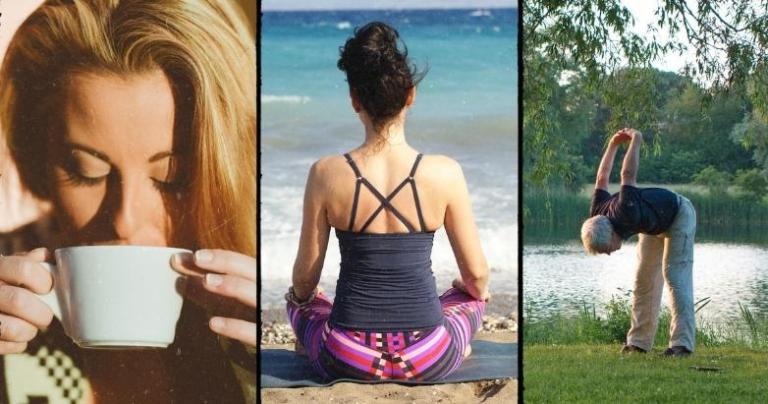
When I was in my mid-twenties, I was convinced—by dozens of books and several New Age and motivational teachers—that improvement could be never-ending, and that inner peace could become permanent if I just kept doing the right things.
In hindsight, this mirage served its purpose and got me to make important changes, but once I saw through it in my early forties, it took the air out of me.
Why continue practicing all these spiritual disciplines, meditation chief among them, if I wasn’t progressing and wouldn’t reach the final destination as promised?
So, I stopped practicing for a while, and that only made things worse. As is so often the case with pain, aka The Motivator, I started asking myself how I could get back to my good habits and what kind of attitude I would need to cultivate to reintegrate them. After all, I had been a yoga and meditation teacher for over twenty years. I had simply lost my motivation.
Months of soul-searching and contemplation—digging through my philosophy books and studying Stoicism, yoga, Vedanta, and the principles of Christian meditation—bore fruit. I replaced my faulty ideas about inner peace with the following three philosophically sound principles that have guided my practice ever since.
Principle 1) Moments Are Impermanent
Time passes. All moments are impermanent.
Plainly speaking, peace is not a destination.
Instead, moments of peace are like rest stops on the highway of life. They can be short (fleeting) or long (moments in time), but they are always temporary.
This idea is not new. The philosophy of impermanency has risen to the surface in various traditions. It reminds us that change is the only constant. All anyone has—especially in the department of feelings—is the present moment.
Principle 2) Peace is Relative
The concept of relativity can be summed up with the words: It depends. Even though most people have a sense of what is peaceful, feelings of peace are dependent on circumstances.
Let me give two examples.
Imagine being in a construction zone. A jackhammer is going full force. The sound is deafening. Suddenly, the jackhammer stops. Ahh. What relief. Even though there is plenty of noise in the background, it feels peaceful when the eardrum-trashing stops.
Now, imagine being at home trying to meditate in silence. The sink starts dripping. The sound, which you would not have heard in the construction zone, is so loud that your moment of peace is disturbed.
As these examples show, feelings of peace depend on various things, such as activity, mental and emotional states, surroundings, degrees of disruption, and more.
That is why we should never accept other people’s definitions of peace without first comparing our lives to theirs. Looking at how a monk practices peace in seclusion may not fit the mold of a teacher with three children whose moment of peace is a cup of coffee before the kids wake up.
I’ve made this mistake several times over the years, looking at other people without comparing their situations and life stories to my own.
Acknowledging relativity allows us to experience moments of peace relative to our circumstances.
Principle 3) The Practice is the Goal
Because moments are impermanent, no one can deposit moments of peace into a bank account and then become permanently peaceful in the future.
Peace does not accumulate.
Instead, peaceful practices are in the same category as brushing teeth—a twice-daily activity with no clear final objective but vital to dental health.
This is important. Many people feel they should be better than they are just because they’ve practiced something (like meditation) for years. That’s like brushing your teeth with the expectation of achieving perfect dental health at some point in the future. Not realistic.
However, when you let go of the myth of a peaceful destination, the commitment shifts to a chosen activity, such as breathing, walking, meditating, relaxing, taking a bath, or any other form of mental and emotional hygiene.
The practice becomes the goal.
Nothing more, nothing less.
It’s doing for the sake of doing.
Integrating these Principles
Honestly, it took me a long time to fully integrate these principles into my life. I had to let go of old beliefs and thought patterns while reminding myself of the self-evident nature of the new principles.
It was especially difficult to let go of the idea of ‘peace always’ and replace it with ‘peace sometimes.’ From my raucous and erratic twenties, I’d hoped to reach a final destination of serenity. I’ve had to remind myself regularly that life will never be stress-free, and that’s okay.
The second principle spurred me to embrace peace in many forms, anything from deep breaths at traffic lights to playing cards with the family. Instead of focusing only on yoga, meditation, and breathing, I am also finding other subtle ways to enjoy moments relative to my circumstances.
The easiest principle to integrate was probably the third one. I was quickly able to change my mindset and approach my chosen practices, especially meditation, with a sense of non-attachment. Instead of expecting to arrive at a final destination, each practice session has become its own reward. Interestingly, my meditation practice has become much more stable, probably because I am no longer berating myself for “not making progress.”
Now It’s Your Turn
Consider the implications as you answer the following questions.
Impermanency: What would life look like if you stopped waiting for it to become more peaceful (destination) and instead savored each moment of peace, willing to let go of it when it was over?
Relativity: What would it feel like if—instead of wishing that life was as peaceful as it was back in the day or chasing someone else’s definition of peace that is far removed from your current circumstances—you could enjoy peace that is relative to your life as it is today?
Goal: What if, while practicing, you could silence the voice that keeps saying, “are we there yet,” and focus instead on the practice without any expectations?
Overall, my practices haven’t changed much, but my attitude has, and that has resulted in more moments of peace. In my next article, I’ll offer seven metaphors that can help you create more moments of peace in your life.
Gudjon Bergmann
Author and Mindfulness Teacher
Amazon Author Profile
Recommended books:
- Monk of All Faiths: Inspired by The Prophet (fiction)
- Spiritual in My Own Way (memoir)
- Co-Human Harmony: Using Our Shared Humanity to Bridge Divides (nonfiction)
- Experifaith: At the Heart of Every Religion (nonfiction)
- Premature Holiness: Five Weeks at the Ashram (novel)
- The Meditating Psychiatrist Who Tried to Kill Himself (novel)
Picture: CC0 License
















